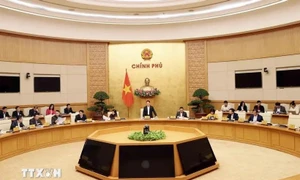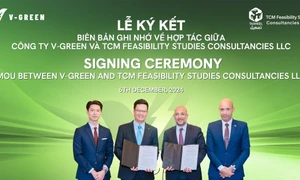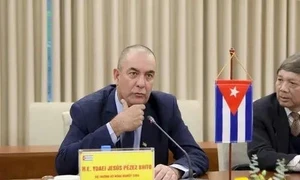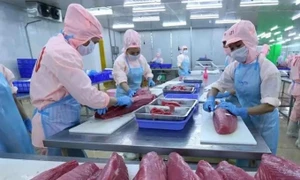
(Photo: VNA)
According to the plans from the two cities, the goal is to complete all planned metro lines by 2035, with a total length of approximately 580.8km - Hanoi’s 397.8km and HCM City’s 183km. By 2045, the two cities aim to add another 369.06km of metro lines, of which Hanoi has 200.7km and HCM City 168.36km.
The total capital demand for the construction by 2035 is estimated in tens of billions of US dollars. The funding is expected to come from four sources, the central budget, city budgets, Transit-Oriented Development (TOD) fund and local government bonds.
According to the Hanoi People's Council, the metro project will be discussed and approved in the meeting next month (July) while the HCM City’s metro development plan has just been reviewed at the 31st session of the city's Party Committee.
The plans will be submitted to the National Assembly for a resolution on mechanisms and policies at the end-of-year session this year.
The Hanoi metro project includes three phases.
In phase 1 from 2024 to 2030, 96.8km of metro line will be completed including lines No. 22, 33, and 5, accounting for about 24% of the total planned length and investment plan for 301km will be prepared to build lines No. 1, 2A, 4, 6, 7 and 8 and connecting satellite cities. The estimated capital will be 37.1 billion USD.
The second phase of 2031-2035 is for 301km, equivalent to about 24% of the total planned length.
And the third phase of 2036-2045, is for 200.7km adjusted and supplemented lines, with an estimated capital demand of 18.2 billion USD.
Hanoi plans to review public investment sources, including budget funds, bond issuance, ODA loans and other lawfully mobilised funds.
Some regulations could be applied according to the draft Capital Law (amended) and growth scenarios being submitted to the National Asembly for approval.
The total capital balance by 2035 will be over 28.5 billion USD.
Hanoi needs Central Government support of about 8.6 billion USD by 2035.
According to Le Hong Son, Permanent Vice Chairman of the Hanoi People's Committee, to reduce budget pressure, the city will supplement policies to attract private investment.
The budget will be used for infrastructure investment, land compensation and resettlement support while the procurement of rolling stock, control systems and information systems will be done through bids.
Private investors will purchase and provide equipment according to selected common standards and technologies, reducing the total costs compared to the current separate implementation method.
Incentive policies for investors will be stable throughout the implementation period of the projects, who will be granted the right to operate part of the infrastructure, participate in investing and developing projects in the designated TOD areas.
Son affirmed that if there are breakthrough mechanisms and policies, Hanoi can absolutely achieve the set goals.
Metro bond issuance
In HCM City, along with metro line No. 1 that is almost complete, line No. 2 is expected to be completed by 2030, said Tran Quang Lam, director of the city's Department of Transport.
The slow investment pace has not met development needs, he said.
The city aims to complete six metro lines by 2035, spanning approximately 183km with an estimated total investment of over 871 trillion VND (over 36 billion USD).
The city has proposed six groups with 28 policies including planning; land recovery, compensation, support and resettlement; capital mobilisation; investment and project implementation procedures and authority; technical and technological standards; and management and exploitation organisation.
"If these mechanisms and policies are approved by the end of this year, we can start preparing for investment next year," Lam said.
The expected capital will be mobilised from increased budget revenues, TOD land auction proceeds and loans.
The city also proposes borrowing through local bond issuance with adjustable interest rates, loans from domestic financial institutions and re-borrowing from the Government's foreign loans, with a total outstanding loan limit not exceeding 120% of the city's budget revenue, he said.
Phan Van Mai, Chairman of People’s Committee of HCM City, said that mobilising 36 billion USD at once is challenging, but raising 3.6 billion USD annually over ten years is feasible.
Actually, this amount of money is not too big, the important thing is the mechanism and policy, Mai said.
The city plans to issue urban bonds under the name of HCM City Urban Railway Bonds, and if approved, the bonds will have interest rates equal to or higher than government bonds, he said.
Addressing challenges
Dr. Nguyen Huu Nguyen, HCM City’s Urban Development Planning Association, emphasised the need for solving financial, technological and human resource issues for successful metro project implementation.
Implementation methods must differ from past practices.
Detailed investment costs, construction timeframes, land clearance complexities and project management are critical for accurate project predictions.
The choice of technology and execution methods are equally important.
Associate Professor Dr. Vu Anh Tuan, Director of the Viet Duc Transport Research Centre, stressed the need for metro network planning linked to urban structure and land use to ensure convenient access and increased TOD area value.
Clear land clearance policies and technology optimisation are crucial for the project to succeed, Tuan said.
By 2035, Hanoi's metro network is expected to handle 35-40% of the public transport demand, while HCM City aims for 50-60%.
























